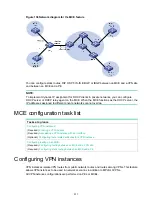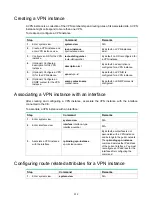
521
Step Command
Remarks
3.
Enter BGP-VPN instance
view.
ip vpn-instance
vpn-instance-name
N/A
4.
Configure the PE as an IBGP
peer.
peer
{
group-name
|
ipv4-address
[
mask-length
] }
as-number
as-number
By default, no BGP peers or
peer groups exist.
5.
Enter BGP-VPN IPv4 unicast
address family view.
address-family ipv4
[
unicast
]
N/A
6.
Enable BGP to exchange
IPv4 unicast routes with the
peer.
peer
{
group-name
|
ipv4-address
[
mask-length
] }
enable
By default, BGP does not
exchange IPv4 unicast routes
with any peer.
7.
Redistribute the VPN routes
of the VPN site.
import-route
protocol
[
process-id
|
all-processes
] [
allow-direct
|
med
med-value
|
route-policy
route-policy-name
] *
By default, no routes are
redistributed into BGP.
Displaying and maintaining MCE
Execute
display
commands in any view.
Task Command
Display VPN instance information.
display ip vpn-instance
[
instance-name
vpn-instance-name
]
For commands that display routing tables for VPN instances, see
Layer 3—IP Routing Command
Reference
.
MCE configuration example
Network requirements
As shown in
, VPN 2 runs RIP. Configure the MCE device to separate routes from different
VPNs and to advertise the VPN routes to PE 1 through OSPF.






























